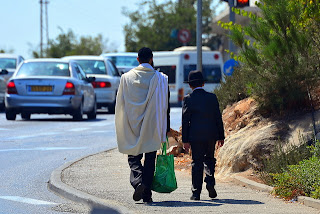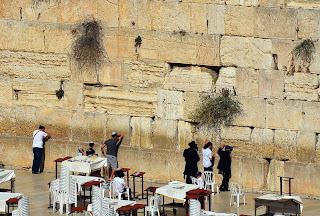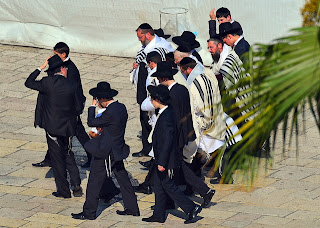We rang in the 5722nd Jewish new year (Rosh Hashanah) with a trip to the "city of peace", Jerusalem. And, given the recent Palestinian bid for statehood at the UN, we hoped that Jerusalem would live up to its name.
In preparation for Rosh Hashanah, we had an "early release" from work on Wednesday--with the shuttle bus leaving at 1pm. This is because the Jewish day begins and ends at sundown (based on the account of creation in Genesis 1:3b, which states: "And there was evening, and there was morning—the first day"). Thus, the early end to the workday enables Israelis to gather with their familes to celebrate and bring in Rosh Hashanah together over dinner.
The Baumer family utilized the early release to go to the beach here in Tel-Aviv, and then to prepare for our trip the next day (Rosh Hashanah) to Jerusalem.
Sammy had been up a couple of times in the night (likely due to excitement over the holiday), so we let him sleep in a bit. By 10:30 or so, we were in the car and on our way to Jerusalem. Along the way, the scenery quickly changed from flat desert-like land to rolling tree-covered hills. While driving uphill most of the way (Jerusalem is at elevation of 800m, as opposed to Tel-Aviv at sea level), we thought of the "cedars of lebanon" being transported from Joppa to Jerusalem, as we had learned last weekend during
our visit to Old Jaffa. It was difficult enough to imagine walking this route 2500 years ago, let alone transporting enormous logs.
The scenery became more and more beautiful, and more and more hilly, as we approached Jerusalem. And finally, after a grueling 40 minute drive, we were there :) It was a funny feeling coming to the realization that such a fascinating destination is only 70km from
our apartment (7km less than
my daily commute to work). Nicki and I asked ourselves: "do we REALLY live here"?
While we'd read that we could park at the Mamilla shopping center near the Old City, we missed the turn and ended up finding a free parking spot at "Bible Hill" (an undeveloped nature preserve apparently referenced in the book of Joshua while describing territorial boundaries). Immediately, we could see the apparently mis-named Mt. Zion across the way...
 |
| Mount Zion with Dormition Abbey (where Jesus' mother Mary is said to have died) at the peak |
We read that centuries ago, Byzantine pilgrims had figured that this hill must be the original site of the City of David, hence naming it Mt. Zion--but while archaelogical evidence later proved otherwise (the City of David is on the adjacent hill), the name stuck.
Here's a father and son we spotted across the street--our first glimpse of many Orthodox Jews we'd see out and about.
 |
| Orthodox Jewish father and son walking on a Jerusalem street |
After a quick view, we loaded up the stroller and walked towards the Jaffa Gate entrance to the Old City of Jerusalem. We'd read that most tourists enter from the Jaffa Gate--and that everything inside the city walls is downhill from there. So, fitting the bill as tourists, we were on our way!
 |
| Jaffa Gate sign just outside the Old City, Jerusalem |
Here is Nicki and Sammy (yes, he's in there!) at the Jaffa Gate...
![nicki]() |
| Nicki sneaking a mysterious bundle into the Jaffa Gate of the Old City |
We were tempted to buy some pomagranates, among the many treats for sale just outside of the Jaffa Gate.
 |
| Pomagranate cart just outside the Jaffa Gate |
Another reason for making this particular gate (of the old city's 11, 7 of which are open) our gate preference is that we'd heard that we could access the "ramparts walk" from Jaffa, which allows visitors to walk on the city walls and peer down into old Jerusalem. We quickly realized, however, that contrary to the advice we'd received from a co-worker, the ramparts walk was off-limits for strollers. In fact, much of the old city was stroller-incompatible due to the hilly terrain and abundance of steps. Perhaps we'll hit the ramparts walk "next time", and leave the stroller in the car. "Next time"--that has a nice ring to it...part of the beauty of living so close to Jerusalem!
We were quickly funneled into the David Street Market, which reminded us of China--complete with bargaining. Here's a shot of some spices (you'll need to try a falafel and/or shwarma sandwich when you visit) for sale at the market.
 |
| Falafel and Shwarma spices, among others, at the David Street Market |
This plate was for sale at the market, and gives you an idea of what written Hebrew looks like (read from right to left). Shalom means peace, but is used as a greeting as well. Check out the caption for a quick Hebrew lesson (admittedly, this is the blind leading the blind...or rather, the mute leading the mute, I suppose).
 |
| Shalom! From right to left, shin ("SH"), lamed ("L"), vav--used as vowel here denoting "oh" sound, mem ("M") |
Here is a view up one of the side "streets" of the Old City...note the narrowness.
 |
| Typical Old City street scene in Jerusalem |
After winding through the labyrinth of Old City streets, we managed to find an observation point overlooking the Wailing Wall (aka Western Wall), which was undoubtedly one of the highlights of our trip.
 |
| Western (Wailing) Wall of Jerusalem with Dome of the Rock mosque looming overhead |
We learned that the Western Wall (Wailing Wall) was constructed ~2000 years ago as a mere retaining wall supporting the western side of the Temple Mount on which the Temple stood. After the temple was deystroyed (AD 70), the exact location of the temple became a mystery--and apparently many Jews made pilgrimage to this wall and mourn their loss (hence, the name). If you're interested in the history, please read elsewhere--there is a lot to be learned, and I don't want to mislead anyone as I'm sure I'd get it wrong :)
 |
| Jewish men overlooking the Wailing Wall (and posing for us, of course) |
Perched upon our look-out point, the people watching was quite interesting. And later, while in the courtyard (actually, an open-air synagogue) in front of the wall, we learned the hard way (via a mild scold) that pictures aren't allowed on shabbat or during holidays. Thus, we were glad that we had snuck in some pics from the overlook before we were privvy to the rules.
As we ventured down some stairs to the courtyard, the sights and sounds intensified. Songs, prayers, and chants filled the air. Bibles and prayer books were being read. Even some tears were beign shed. After washing my hands in the fountain, I proceeded towards the wall! At once, I greeted with more scolding (in Hebrew), then another woman translated for me: "this side is for women!". Oops. Embarrassed, I made my way back to the courtyard, and then over to the men's side. I donned one of the free-for-use kippas, and headed to the wall. While I believe that we can approach God from anywhere, I must admit that praying at the Wailing Wall was a powerful experience! Nicki then took a turn (on the appropriate side, of course), and I looked on as many of the women walked backwards away from the wall (perhaps a foreshadowing of an unusual traffic pattern on our way to Caesarea the next day...more to come on that), rather than turning their backs on it.
Here is a shot of some Jews praying fervently at the wailing wall (men's side). Jewish tradition states that the Divine Presence never deserted the wall, so the thought is that chances of getting a prayer uttered at the wall answerd are quite high!
 |
| Jews praying at the Wailing Wall in Jerusalem |
Here is a group of Orthodox Jews approaching the wall.
We saw several Israeli soldiers (note the guns--not uncommon here in Israel) guarding the Western Wall area. We weren't sure how to interpret the situation--was it good to have soldiers keeping us safe, or does the presence of soldiers indicate the likelihood of an incident? Given the controversial nature of the area in general, probably the latter, but it seemed to work out ok.
 |
| Israeli soldiers keeping watch over the Western Wall |
Oh, and there are no fears of gender bias with regards to military recruitment here in Israel. We've seen plenty of female soldiers & policewomen on guard. In fact, we've learned that all Israeli young-adults, with the exception of those who opt out based on religious convictions, are required to serve two years in the military. Many of them, we've come to find, then spend another year traveling the world. This explains why my co-workers with similar years of experience seem to be a few years older--they get a later start in the workforce. An all-volunteer military is certainly something that we take for granted in the US.
 |
| Israeli Policewomen guarding the Western Wall in Jerusalem |
The Dome of the Rock mosque sits atop the Temple Mount, the previous site of the Jewish Temple (originally built by King Solomon), which had been deystroyed--twice.
 |
| Gold roof atop Dome of the Rock on the Temple Mount |
And here's a view of the adjacent Al-Aqsa mosque. Our Muslim friends can correct me via comments if I'm wrong, but we've learned that Al-Aqsa ("the furthermost") mosque is considered to be the third holiest Islamic site in the world, behind Mecca and Medina--both of which are in Saudi Arabia.
 |
| Al-Aqsa Mosque, Old City Jerusalem |
From there, we ventured through the Muslim Quarter and then stumbled upon Via Dolorosa. Actually, first we stopped for a quick treat.
 |
| Nicki and Sammy enjoying some chocolate cake and mint tea in the Muslim Quarter, Old Jerusalem |
And, on the way, we spotted these guys playing backgammon...
 |
| Men playing backgammon on the streets of the Muslim Quarter, Old Jerusalem |
Oh, and in order to give you an idea of what "new" Jerusalem looks like--here is a vew of the city looking out over Old City's wall.
 |
| Jerusalem as viewed from inside the Old City looking out over the wall |
Ok, now back to Via Dolorosa.
 |
| Via Dolorosa street sign in Hebrew and Arabic |
Via Dolorosa is Latin for "way of suffering". And, some think, it is the path that Jesus took on the way to Calvary. We knew we were in the right place when we saw this guy carrying a cross. As it turned out, he was taking it to the beginning of Via Dolorosa, where a group of Europeans was starting the walking tour.
 |
| Man carrying a cross on Via Dolorosa, Jerusalem |
Here is one such group...
 |
| Group of Christians traverse Via Dolorosa |
We also saw a long-haired, barefoot man garbed in a white robe walking the streets. We thought perhaps he had a case of "Jerusalem Syndrome", a widely recognized mental phenomena which apparently affects around 50 Jerusalem visitors per year.
Visitors can re-trace Jesus' steps, stopping along the way at 14 "stations", which mark the purported places that particular events documented in the gospels took place. Here's a map of the Via Dolorosa stations:
 |
| Map of Via Dolorosa walking tour stations |
We had mixed emotions while walking Via Dolorosa. On one hand, it was amazing and humbling to walk where Jesus may have walked 2000 years ago. On the other hand, it also had the feel of a tourist trap--complete with coffee shops, trinket stands, and even the "Holy Rock Cafe". We also made way for skaters, a car with booming bass, and an ambulance.
 |
| Holy Rock Cafe, Via Dolorosa, Jerusalem |
The culmination of Via Dolorosa is the Church of the Holy Sepulchre, said to stand on the spot where the crucifixion took place. It even houses a site (the 14th "station") marking what some say was the tomb of Jesus. The decision to put a church here was apparently made by Helena, the mother of Emperor Constantine, AD300. In those days, it was an empty piece of land outside of the city walls.
 |
| Courtyard outside the Church of the Holy Sepulchre, Jerusalem |
While we were there, some sort of ceremony was taking place. An uknown language was being chanted, and a guy was swinging a smoking lantern around (Nicki said it was incence). It reminded me of how many variations of "Christianity" there are. Apparently, even within this single church, there are many sects (Greek Orthodoxy, Coptic Monks, etc) sharing real estate.
 |
| Ritual underway inside the Church of the Holy Sepulchre |
We had also learned that others claim that Jesus' crucifixion took place at a completely different location, near the Garden Tomb. So, perhaps Via Dolorosa is just wishful thinking.
Regardless, no one denies that Jesus Christ was crucified here in Jerusalem. Yes, it REALLY happened... The important part is that He rose again (!!), as witnessed by His disciples, many of whom literally gave their lives sharing the news (after initially giving up on Him just after His death). Praise be to God! Wow, right here in Jerusalem!


























Tempted by pomegranates? Snort. Nice one, Craig!
ReplyDelete